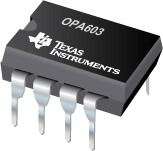Amplificador operacional de alta velocidad con retroalimentación de corriente 16-SOIC
PDF, 33 Kb, Archivo publicado: sept 27, 2000
Current-feedback amplifiers have nearly constant bandwidth for varying closed-loop gains. The reason is that the user can adjust the open-loop gain of the current-feedback amplifier by changing the feedback network without affecting the open-loop pole.
PDF, 32 Kb, Archivo publicado: sept 27, 2000
Classical op amps such as the OPA627 have excellent performance in applications where the required gain bandwidth is low compared to the gain-bandwidth product of the op amp. However, increasing closed-loop gain decreases the error-reducing loop gain. Furthermore, starting at relatively low frequencies, the loop gain rolls-off at 20dB/decade of signal frequency increase. In combination these effec
PDF, 117 Kb, Archivo publicado: oct 2, 2000
Although current-feedback amplifiers (CFAs) have been in use for quite some time, there is a reluctance to view them in the same light as voltage-feedback amplifiers (VFAs). For instance, the gain-bandwidth curve of VFAs has a parallel in a transimpedance-bandwidth curve for CFAs. This parameter can be used to determine the closed-loop behavior of the CFA in same way that GBW can for the VFA. Not
PDF, 256 Kb, Revisión: A, Archivo publicado: enero 17, 2005
As system bandwidths have increased an accurate estimate of the noise contribution for each element in the signal channel has become increasingly important. Many designers are not however particularly comfortable with the calculations required to predict the total noise for an op amp or in the conversions between the different descriptions of noise. Considerable inconsistency between manufactu
